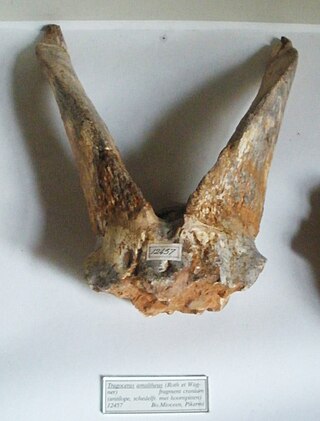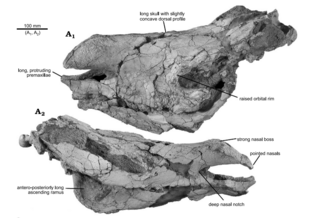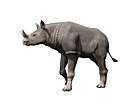
A rhinoceros, commonly abbreviated to rhino, is a member of any of the five extant species of odd-toed ungulates in the family Rhinocerotidae; it can also refer to a member of any of the extinct species of the superfamily Rhinocerotoidea. Two of the extant species are native to Africa, and three to South and Southeast Asia.

Diceros is a genus of rhinoceros containing the extant black rhinoceros (Diceros bicornis) and several extinct species.

Ceratotherium is a genus of the family Rhinocerotidae, consisting of a single extant species, the white rhinoceros, as well as several fossil species.

Victoriapithecus macinnesi was a primate from the middle Miocene that lived approximately 15 to 17 million years ago in Northern and Eastern Africa. Through extensive field work on Maboko Island in Lake Victoria, Kenya, over 3,500 specimens have been found, making V. macinnesi one of the best-known fossil primates. It was previously thought that perhaps multiple species of Victoriapithecus were found, however the majority of fossils found indicate there is only one species, V. macinnesi. Victoriapithecus shows similarities to the extant subfamilies Colobinae and Cercopithecinae. However, Victoriapithecus predates the last common ancestor of these two groups and instead is thought to be a sister taxon.

Rusinga Island, with an elongated shape approximately 10 miles (16 km) from end to end and 3 miles (5 km) at its widest point, lies in the eastern part of Lake Victoria at the mouth of the Winam Gulf. Part of Kenya, it is linked to Mbita Point on the mainland by the new Rusinga-Mbita bridge which replaced the old causeway.

Ancylotherium is an extinct genus of the family Chalicotheriidae, subfamily Schizotheriinae, endemic to Europe, Asia, and Africa during the Late Miocene-Early Pleistocene, existing for approximately 9.8 million years.

Ceratotherium neumayri is a fossil species of rhinoceros from the Late Miocene (Vallesian-Turolian) of the Balkans and Western Asia, with remains known from Greece, Bulgaria, Iran, and Anatolia in Turkey.

Aphelops is an extinct genus of hornless rhinocerotids endemic to North America. It lived from the Middle Miocene to the early Pliocene, during which it was a common component of North American mammalian faunas along with Teleoceras.
Rusingaceros or Dicerorhinus leakeyi is an extinct genus of rhinocerotid known from the Miocene of Rusinga Island, Kenya.
Damalborea is an extinct genus of alcelaphine bovid. It was first named by Alan W. Gentry in 2010, and the type species is Damalborea elisabethae. It is known from the holotype AL 208–7, a skull with horn cores collected from the Middle Pliocene Hadar Formation Member SH-3 of Ethiopia. In addition, a fossils of this or a closely related species were collected from Aramis, Wee-ee and Maka localities in the Middle Awash deposits, lower and upper units of the Laetolil Beds, as well as Tulu Bor Member and an unknown horizon of the Koobi Fora Formation. Geraads, Bobe & Reed (2012) assigned all Damalborea specimens from the Basal Member and Sidi Hakoma member of the Hadar Formation to the species D. elisabethae; in addition, the authors named the second species, Damalborea grayi, described on the basis of fossils from the Denen Dora member of the Hadar Formation. Damalborea was a moderately large alcelaphine with high and narrow skull proportions.
Simiolus is an extinct genus of dendropithecid primates. It was described by Mary Leakey and Richard Leakey in 1987, and the type species is S. enjiessi, which existed during the Miocene of Kenya. The species epithet is a phonetic pun on the acronym NGS. A new species, S. andrewsi, also from the middle Miocene of Kenya, was described by Terry Harrison in 2010. In November 2018, scientists reported the discovery of the smallest known ape, Simiolus minutus, which weighed approximately 8 lb (3.6 kg), and lived about 12.5 million years ago in Kenya in East Africa.
This paleomammalogy list records new fossil mammal taxa that were described during the year 2012, as well as notes other significant paleomammalogy discoveries and events which occurred during that year.
Brochuchus is an extinct genus of crocodile known from the Early Miocene Hiwegi Formation of Rusinga Island in Lake Victoria, Kenya; it was originally named as a species of Crocodylus. It contains two species, B. parvidens and B. pigotti. Brochuchus belongs to the family Crocodylidae, which includes all living crocodiles. The closest living relative of Brochuchus is Osteolaemus, the dwarf crocodile. Compared to Osteolaemus, which has a small body and blunt snout, Brochuchus has a more generalized crocodylid anatomy. Brochuchus is characterized by a flat and relatively narrow skull, and although it is larger than Osteolaemus it is smaller than most other crocodylids. It has two prominent bumps on the surface of its snout.

Tragoportax is an extinct genus of bovid ungulate. It lived during the upper Miocene, and its fossils have been found in Europe, Asia and Africa. Tragoportax is sometimes considered to have been a close relative of the extant nilgai, though it may have formed its own subfamily, along with Miotragocerus.
Micropithecus is an extinct genus of primates that lived in East Africa about 19 to 15 million years ago, during the early Miocene. The genus and its type species, Micropithecus clarki, were first scientifically described in 1978.

Nyanzapithecus pickfordi is an extinct species of primate from the Middle Miocene of Maboko Island, Nyanza Province, Kenya. It had an average body mass of around 10 kg (22 lb).

Eoazara xerrii is a species of extinct elasmotheriine rhinoceros from the upper Miocene of Morocco, the first definitive representative of the subfamily in North Africa. It is known from a well preserved skull and postcranial material, preserving the most complete late Miocene rhino skull found in Africa.

Kinyang is an extinct genus of osteolaemine crocodile from the Early to Middle Miocene of Kenya. Two species are currently known, K. mabokoensis from the Lake Victoria basin and K. tchernovi from the Lake Victoria and Lake Turkana basin. Kinyang had an exceptionally broad and robust skull, much wider than that of any living crocodile species. This might have allowed it to attack and kill prey its own size or even bigger. Kinyang is notably larger than its contemporary relative Brochuchus. While the precise reasons for the extinction of Kinyang are not known, it coincides with a larger faunal turnover that saw osteolaemines replaced by the still dominant crocodylines. One reason for this shift may have been the drying climate of Africa at the time, which caused rainforests to be replaced by more open environments and disrupted the nesting behavior of osteolaemines due to their dependence on foliage.
The Hiwegi Formation is a geological formation on Rusinga Island in Kenya preserving fossils dating to the Early Miocene period. The Hiwegi Formation is known for the well preserved plant fossils it preserves, which indicate a tropical forest environment that underwent wet and dry periods. The middle members of the formation in particular indicate a brief period in which conditions were notably dryer with a more open environment compared to older and younger units. Some of the formation's fauna, such as an early ancestor of the modern aye-aye and a chameleon of the genus Calumma, link Miocene East Africa to modern day Madagascar.
Asilifelis is an extinct genus of small felid that lived in what is now Kenya during the Early Miocene. Despite its fragmentary remains, it is remarkable because of its small size and advanced dentition. It contains a single species, Asilifelis cotae.





















